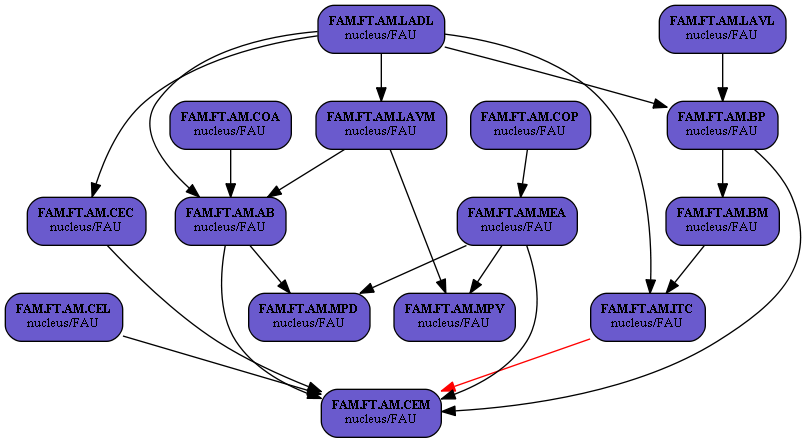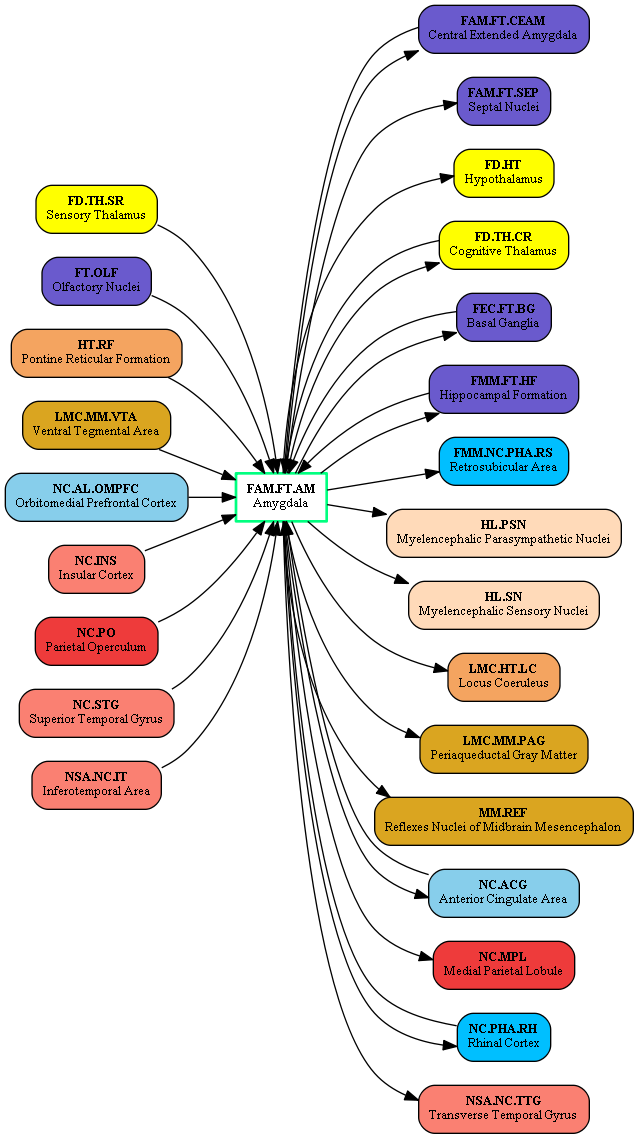Difference between revisions of "BrainCenterFAM FT AM"
From aHuman Wiki
(Automated page entry using MWPush.pl) |
(Automated page entry using MWPush.pl) |
||
| Line 113: | Line 113: | ||
| [[BrainCenterHBA_FT_HF|Hippocampal Formation]] (HBA.FT.HF) || [http://www.sciencedirect.com/science/article/pii/S030100820900183X Simplified model of hippocampal formation anatomy (SUB -> Amyg, abstract)] | | [[BrainCenterHBA_FT_HF|Hippocampal Formation]] (HBA.FT.HF) || [http://www.sciencedirect.com/science/article/pii/S030100820900183X Simplified model of hippocampal formation anatomy (SUB -> Amyg, abstract)] | ||
|- | |- | ||
| − | | [[ | + | | [[BrainCenterHT_RF|Pontine Reticular Formation]] (HT.RF) || [http://neuropolitics.org/defaultmay10.asp Amygdalar disruption of prefrontal cortex (PB -> AM, abstract)] |
|- | |- | ||
| [[BrainRegionLMC_MM_VTA|Ventral Tegmental Area]] (LMC.MM.VTA) || [http://neurowiki2012.wikispaces.com/Presynaptic+Mechanisms+of+Synaptic+Plasticity Reward circuit of human brain (VTA -> AM, abstract)] | | [[BrainRegionLMC_MM_VTA|Ventral Tegmental Area]] (LMC.MM.VTA) || [http://neurowiki2012.wikispaces.com/Presynaptic+Mechanisms+of+Synaptic+Plasticity Reward circuit of human brain (VTA -> AM, abstract)] | ||
| Line 149: | Line 149: | ||
| [[BrainCenterHBA_FT_HF|Hippocampal Formation]] (HBA.FT.HF) || [https://books.google.ru/books?id=P3fSBwAAQBAJ Detailed amygdalohippocampal projections (ABmg -> CA1P)] | | [[BrainCenterHBA_FT_HF|Hippocampal Formation]] (HBA.FT.HF) || [https://books.google.ru/books?id=P3fSBwAAQBAJ Detailed amygdalohippocampal projections (ABmg -> CA1P)] | ||
|- | |- | ||
| − | | [[ | + | | [[BrainCenterHL_PSN|Myelencephalic Parasympathetic Nuclei]] (HL.PSN) || [http://www.surgicalneurologyint.com/article.asp?issn=2152-7806;year=2012;volume=3;issue=2;spage=40;epage=46;aulast=Langevin Amygdala and its network (CEA -> VGDM, abstract)] |
|- | |- | ||
| − | | [[ | + | | [[BrainCenterHL_SN|Myelencephalic Sensory Nuclei]] (HL.SN) || (unknown reference) |
| − | + | ||
| − | + | ||
|- | |- | ||
| [[BrainCenterHTA_FD_HT|Hypothalamus]] (HTA.FD.HT) || [http://www.pnas.org/content/107/40/17071/F1.expansion.html Role for serotonin in moral behavior (AMY -> HYP, abstract)] | | [[BrainCenterHTA_FD_HT|Hypothalamus]] (HTA.FD.HT) || [http://www.pnas.org/content/107/40/17071/F1.expansion.html Role for serotonin in moral behavior (AMY -> HYP, abstract)] | ||
| + | |- | ||
| + | | [[BrainRegionLMC_HT_LC|Locus Coeruleus]] (LMC.HT.LC) || [http://neuropolitics.org/defaultmay10.asp Amygdalar disruption of prefrontal cortex (AM -> LC, abstract)] | ||
|- | |- | ||
| [[BrainRegionLMC_MM_PAG|Periaqueductal Gray Matter]] (LMC.MM.PAG) || [http://neuropolitics.org/defaultmay10.asp Amygdalar disruption of prefrontal cortex (AM -> PAG, abstract)] | | [[BrainRegionLMC_MM_PAG|Periaqueductal Gray Matter]] (LMC.MM.PAG) || [http://neuropolitics.org/defaultmay10.asp Amygdalar disruption of prefrontal cortex (AM -> PAG, abstract)] | ||
Revision as of 10:02, 28 July 2015
Amygdala
@@Home -> BiologicalLifeResearch -> BrainCenterFAM_FT_AM
This page covers biological details of component group Amygdala. Component group is part of aHuman target integrated biological model.
- Top-down path to center: Forebrain Telencephalon -> Extended Amygdala (FAM.FT.EXTAM) -> Amygdala (FAM.FT.AM) (see Mind Maps)
- Function: Experiencing and recognizing emotions
(generated)
Components
(generated)
Component items:
- Basolateral Nuclear Complex (FAM.FT.AM.BL): stimulating emotional response
- Lateral Amygdaloid Nucleus (FAM.FT.AM.LA): plasticity, conditional (neutral stimulus) to specific (taste, smell, visceral) unconditional (positive or negative stimulus) association
- Dorsolateral Amygdaloid Nucleus (FAM.FT.AM.LADL): conditional stimulus input - high-aggregated visual, auditory and somatic, patterns of perception
- Ventrolateral Amygdaloid Nucleus (FAM.FT.AM.LAVL): unconditional stimulus input - visual, auditory and somatic, convergence from thalamus
- Ventromedial Amygdaloid Nucleus (FAM.FT.AM.LAVM): conditional and unconditional convergence to affect polymodal memory formation
- Basal Amygdaloid Nucleus (FAM.FT.AM.B): enhance explicit memories in hippocampus about emotional situations
- Parvicellular Basal Amygdaloid Nucleus (FAM.FT.AM.BP): enhance explicit memories in hippocampus about emotional situations
- Magnocellular Basal Amygdaloid Nucleus (FAM.FT.AM.BM): enhance emotional memories memories in medial prefrontal cortex
- Accessory Basal Amygdaloid Nucleus (FAM.FT.AM.AB): enhance assotiative memory formation
- Lateral Amygdaloid Nucleus (FAM.FT.AM.LA): plasticity, conditional (neutral stimulus) to specific (taste, smell, visceral) unconditional (positive or negative stimulus) association
- Corticomedial Nuclear Complex (FAM.FT.AM.CTM)
- Cortical Amygdaloid Nucleus (FAM.FT.AM.CO): olfactory processing
- Anterior Cortical Amygdaloid Nucleus (FAM.FT.AM.COA): olfactory processing - conditional contextual signaling
- Posterior Cortical Amygdaloid Nucleus (FAM.FT.AM.COP): olfactory processing - unconditional signaling
- Centromedial Nuclei (FAM.FT.AM.CM): attention and arousal
- Central Amygdala (FAM.FT.AM.CEA): mediate behavioral responses, link to general aspects of reinforcement; responses to fear stimuli; directing attention and behaviors when salience of competing stimuli is in flux
- Central Amygdaloid Nucleus, capsular subdivision (FAM.FT.AM.CEC): mediate behavioral responses, link to striatal effect
- Central Amygdaloid Nucleus, lateral subdivision (FAM.FT.AM.CEL): mediate behavioral responses, link to gustatory and visceral aspects of reinforcement
- Medial Central Amygdaloid Nucleus (FAM.FT.AM.CEM): mediate behavioral responses, output projections
- Medial Amygdala (FAM.FT.AM.M): sense of smell and pheromone-processing
- Medial Anterior Amygdaloid Nucleus (FAM.FT.AM.MEA): olfactory processing
- Medial Posteror Dorsal Amygdaloid Nucleus (FAM.FT.AM.MPD): reproductive behavior
- Medial Posteror Ventral Amygdaloid Nucleus (FAM.FT.AM.MPV): defensive behavior
- Central Amygdala (FAM.FT.AM.CEA): mediate behavioral responses, link to general aspects of reinforcement; responses to fear stimuli; directing attention and behaviors when salience of competing stimuli is in flux
- Cortical Amygdaloid Nucleus (FAM.FT.AM.CO): olfactory processing
- Intercalated Amygdaloid Nuclei (FAM.FT.AM.ITC): inhibit excessive emotional behavior
Connectivity
(generated)
Internal Regions Connections:

External Connections:

External Inbound Center Connections:
External Outbound Center Connections: